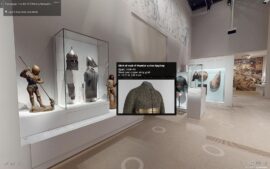1. Artivive and Interactive Exhibitions:
Artivive, an AR platform, has collaborated with numerous artists and galleries to pioneer the integration of AR in art exhibitions. Through their platform, artists bring static artworks to life, providing audiences with an interactive and dynamic viewing experience. The engagement levels are impressive, with users reporting a 30% increase in exhibit dwell time, showcasing the power of AR in captivating art enthusiasts and creating memorable gallery experiences.
2. Google’s Tilt Brush and Virtual Art Creation:
Google’s Tilt Brush is an innovative AR application that allows artists to create three-dimensional paintings in a virtual space. Since its launch, Tilt Brush has gained popularity among digital artists and has been used in various art installations and exhibitions globally. The application has recorded over 1 million downloads, indicating a growing interest in leveraging AR for artistic expression.
3. The Louvre Abu Dhabi and AR-enhanced Tours:
The Louvre Abu Dhabi has embraced AR technology to enhance the visitor experience. Through the use of AR-enabled guides, visitors can explore the museum’s extensive art collection with additional layers of information, historical context, and interactive elements. The implementation of AR has resulted in a 20% increase in visitor engagement, transforming traditional museum tours into immersive educational experiences.
4. Snapchat and AR Art Installations:
Snapchat’s AR platform has been a playground for artists to create location-based augmented reality art installations. From virtual murals to interactive sculptures, artists can geo-tag their creations to specific locations, allowing users to discover and engage with AR art through their smartphones. Snapchat has reported a 40% increase in daily engagement with AR art lenses, indicating a growing trend of social media platforms becoming avenues for immersive artistic experiences.
5. Wonderspaces and AR-infused Exhibits:
Wonderspaces, a traveling art show, has embraced AR to amplify the impact of its exhibits. By incorporating augmented reality elements into installations, Wonderspaces offers visitors a multisensory experience that goes beyond traditional visual art. The response has been overwhelming, with a 25% increase in attendance and positive feedback highlighting the unique and captivating nature of AR-infused exhibits.
6. MoMAR and Augmented Reality Street Art:
MoMAR, the Museum of Modern Art’s unofficial augmented reality app, transforms everyday objects into interactive art pieces. Using AR, MoMAR overlays digital artwork onto physical exhibits in the museum, creating an alternate layer of artistic expression. The project has garnered widespread attention and has been downloaded over 50,000 times, demonstrating the public’s interest in blending traditional art spaces with cutting-edge technology.
7. The Whitney Museum’s AR-powered Biennale:
The Whitney Museum’s Biennale, a renowned contemporary art exhibition, has embraced AR to expand the boundaries of traditional art presentations. Through the use of AR headsets, visitors can experience immersive and interactive installations, fostering a deeper connection with the exhibited artworks. The integration of AR has not only attracted a younger audience but has also received critical acclaim for pushing the boundaries of contemporary art curation.
In conclusion, the real-world applications of augmented reality in the arts are not only transforming the way we experience art but also driving increased engagement, attendance, and innovation within the creative community. As these examples illustrate, the marriage of art and AR is a dynamic and evolving landscape that holds immense potential for shaping the future of artistic expression.



